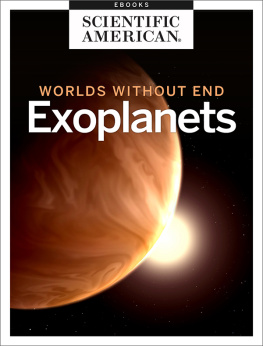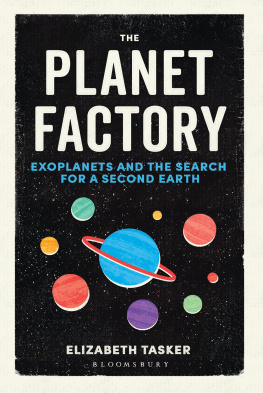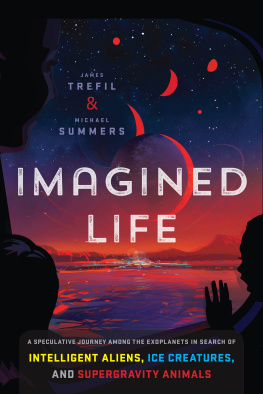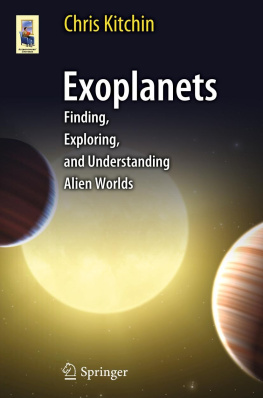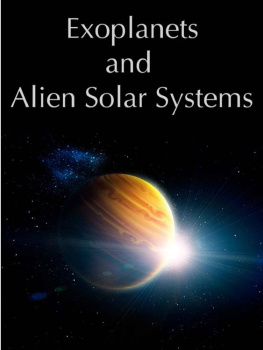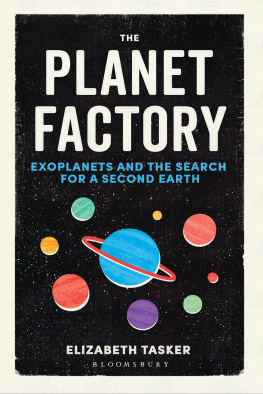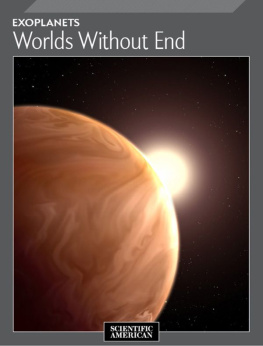Scientific American - Exoplanets: Worlds Without End
Here you can read online Scientific American - Exoplanets: Worlds Without End full text of the book (entire story) in english for free. Download pdf and epub, get meaning, cover and reviews about this ebook. year: 2015, publisher: Scientific American, genre: Children. Description of the work, (preface) as well as reviews are available. Best literature library LitArk.com created for fans of good reading and offers a wide selection of genres:
Romance novel
Science fiction
Adventure
Detective
Science
History
Home and family
Prose
Art
Politics
Computer
Non-fiction
Religion
Business
Children
Humor
Choose a favorite category and find really read worthwhile books. Enjoy immersion in the world of imagination, feel the emotions of the characters or learn something new for yourself, make an fascinating discovery.
- Book:Exoplanets: Worlds Without End
- Author:
- Publisher:Scientific American
- Genre:
- Year:2015
- Rating:4 / 5
- Favourites:Add to favourites
- Your mark:
- 80
- 1
- 2
- 3
- 4
- 5
Exoplanets: Worlds Without End: summary, description and annotation
We offer to read an annotation, description, summary or preface (depends on what the author of the book "Exoplanets: Worlds Without End" wrote himself). If you haven't found the necessary information about the book — write in the comments, we will try to find it.
Scientific American: author's other books
Who wrote Exoplanets: Worlds Without End? Find out the surname, the name of the author of the book and a list of all author's works by series.
Exoplanets: Worlds Without End — read online for free the complete book (whole text) full work
Below is the text of the book, divided by pages. System saving the place of the last page read, allows you to conveniently read the book "Exoplanets: Worlds Without End" online for free, without having to search again every time where you left off. Put a bookmark, and you can go to the page where you finished reading at any time.
Font size:
Interval:
Bookmark:

Exoplanets
Worlds Without End
From the Editors of Scientific American
Cover Image: NASA, ESA and G. Bacon (STScI)
Letters to the Editor
Scientific American
One New York Plaza
Suite 4500
New York, NY 10004-1562
or editors@sciam.com
Copyright 2017 Scientific American, a division of Nature America, Inc.
Scientific American is a registered trademark of Nature America, Inc.
All rights reserved.
Published by Scientific American
www.scientificamerican.com
ISBN: 978-1-4668-5898-5
Scientific American and Scientific American MIND are trademarks of Scientific American, Inc.,
used with permission.


EXOPLANETS
Worlds Without End
From the Editors of Scientific American
Table of Contents
Introductionby Jesse Emspak
Section 1
1.1
by John Matson
1.2
by Michael D. Lemonick
1.3
by John Matson
1.4
by Caleb A. Scharf
1.5
by Caleb A. Scharf
Section 2
2.1
by Ken Croswell
2.2
by Caleb A. Scharf
2.3
by Kelly Oakes
Section 3
3.1
by Dimitar D. Sasselov and Diana Valencia
3.2
by Ron Cowen
3.3
by Ron Cowen
3.4
by John Matson
3.5
by John Matson
3.6
by Lee Billings
3.7
by Ren Heller
Section 4
4.1
by Charles Choi
4.2
by John Matson
4.3
by Michael W. Werner and Michael A. Jura
4.4
by John Matson
4.5
by George Musser
4.6
by JR. Minkel
4.7
by William F. Welsh and Laurance R. Doyle
Section 5
5.1
by John Matson
5.2
by Lee Billings
5.3
by John Matson
5.4
by Tim Folger
5.5
by Nancy Y. Kiang
Section 6
6.1
by Stephanie D. Leifer
6.2
by Cameron M. Smith
Exoplanets: Worlds Without End
Science fiction writers have been dreaming of other planets from the start. There's the desert planet Arrakis from Dune , the jungles world Endor in Return of the Jedi , and a global ocean in Solaris . None of these fictional planets has proven as strange as the real thing.
The very first planets orbiting another star, called exoplanets, were discovered in 1992. They were big, rocky worlds circling the remains of a star that exploded as it died. It's likely they are the stripped cores of gas giants that survived the cataclysm.
Three years later astronomers found a planet around a star like our sun, called 51 Pegasi. The planet, 51 Pegasi b, wasn't any less weird. It was a gas giant like Jupiter, but the resemblance ended there. This one sped around in a 4.2-day orbit, closer to its star than Mercury is to our sun. By itself it upended theories of planet formation.
Since then, scientists have found more than 1,000 exoplanets, with thousands more potential candidates. They seem to be everywhere. And if anything, our solar system seems to be the strange one.
Or at least its the strange one so far . Improving the way we search has resulted in more findings, but also more questions about those findings and what they mean. This eBook is a collection of stories about what we currently know, and its exciting to think that it could all change tomorrow.
Section 1, Exo-Search, delves into those improved techniques of how astronomers are looking for new worlds. Finding these miniscule specks of light seems impossible by rights they should be drowned out by light from their stars. But in "A Plentitude of Planets" and "The Dawn of Distant Skies," we see that a combination of space-based telescopes, careful ground-based observations and better instruments opened up the field, and the discoveries have come thick and fast.
Sometimes a little too fast. Section 3 focuses on the race to find other Earth-like planets. With excitement at an all-time high, author Ron Cowen cautions against publishing too quickly out of optimism. In Noisy Stars May Create Phantom Planets, Cowen describes how stellar activity can mimic the signs of tiny exoplanets. In the case of Gliese 581, a star located in an area called the Goldilocks Zone, one research team announced the discovery of a planet circling the star, but another used different method to analyze the data and saw nothing. Still, several possibilities have been found, and the other articles in this section look at the potential Earth-like planets out there.
"Earth-like" is a loose term, referring to planets made of rock, but astronomers actually found the giant, Jupiter-like exoplanets first. Section 2 discusses these gas giants, which come in many sizes, and as "The Varied Lives of 'Hot Jupiters'" shows, they can start their journeys in the outer reaches of a system and drift in, or spin placidly far from their primary. It's lucky for us that the gas giants of our system stayed put.
In Section 4, we get to the real oddballs. They may be remnants of gas giants whose atmospheres were stripped away, as in the piece, "The Bones of Giants," or have alien chemistries. Some trace their course around white dwarfs, the results of a second generation of planets forming around old stars.
But is there life out there? That's the focus of the fifth section. Prospects look good in one sense there are billions of planets. But how often does life arise, and how tenacious is it? In "Anybody Home?" John Matson outlines the search for the chemical signatures that scientists think are telltale signs that we're not the only living things in this part of the universe.
Of course, no collection would be complete without a look at getting to those worlds we found, and the challenge encompasses both technology and the way we build societies, and even our biology.
It won't be like the visions we see in science fiction. It will be stranger wonderfully so.
--Jesse Emspak
Book Editor


A Plentitude of Planets
by John Matson
The next time you look up at the night sky and find yourself marveling at thenumber of stars overhead, know that you are only seeing part of the magnificentbounty that our galaxy holds. Most of those Milky Way stars are not isolated orbs.Rather an average star has at least one planetary companion, invisible to the nakedeye and in most cases as yet unseen by telescopes, according to a new analysis.
That extrasolar planets should be even more common than stars, which themselvesseem innumerable, lends support to the hope that somewhere up in the night sky,circling one of those stars, is a world like Earth where life may have had a chance totake root, and maybe even have evolved into an intelligent form.
The analysis of planetary frequency in the Milky Way appeared in Nature. (Scientific American is part of Nature Publishing Group.) Theresearchers, led by astronomer Arnaud Cassan of the Paris Institute of Astrophysicsat University Pierre and Marie Curie, used a small sample of planetary discoveriesto infer the size of the overall planetary population. Extrapolating from a fewknown planets and the relatively low probability that each of those planets shouldbe detectable from Earth, the researchers found that each star is home to anaverage of 1.6 planets.
Font size:
Interval:
Bookmark:
Similar books «Exoplanets: Worlds Without End»
Look at similar books to Exoplanets: Worlds Without End. We have selected literature similar in name and meaning in the hope of providing readers with more options to find new, interesting, not yet read works.
Discussion, reviews of the book Exoplanets: Worlds Without End and just readers' own opinions. Leave your comments, write what you think about the work, its meaning or the main characters. Specify what exactly you liked and what you didn't like, and why you think so.

